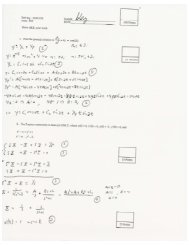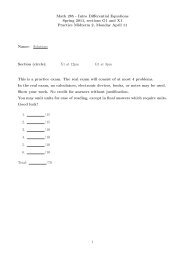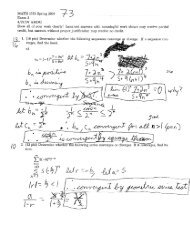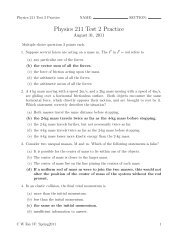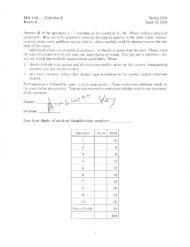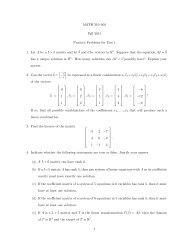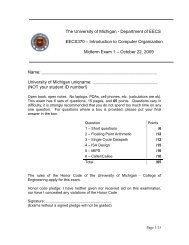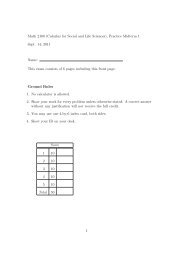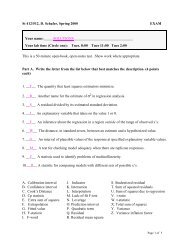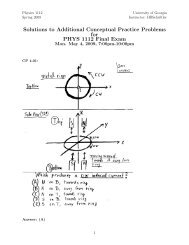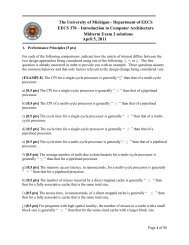Physics 211 Practice Test 3
Physics 211 Practice Test 3 - We Tall Did Test Bank
Physics 211 Practice Test 3 - We Tall Did Test Bank
Create successful ePaper yourself
Turn your PDF publications into a flip-book with our unique Google optimized e-Paper software.
<strong>Physics</strong> <strong>211</strong> <strong>Practice</strong> <strong>Test</strong> 3 NAME: SECTION:Multiple choice questions 2 points each.<strong>Physics</strong> <strong>211</strong> <strong>Practice</strong> <strong>Test</strong> 3August 24, 20111. A car, driven around a circle with a constant speed, must have(a) zero acceleration.(b) a centrifugal acceleration.(c) zero velocity.(d) a centripetal acceleration.(e) a tangential acceleration.2. Stress is(a) the ratio of the change in length.(b) the strain per unit length.(c) the same as the force.(d) applied force per cross-sectional area.3. What condition or conditions is/are necessary for static equilibrium?(a) ∑ F y = 0(b) ∑ F x = 0, ∑ F y = 0(c) ∑ τ = 0(d) ∑ F x = 0(e) ∑ F x = 0, ∑ F y = 0, ∑ τ = 04. A boy and a girl are riding on a merry-go-round that is turning. The boy is twice asfar as the girl from the merry-go-round’s center. If the boy and girl are of equal mass,which statement is true about the boy’s moment of inertial with respect to the axis ofrotation?(a) His moment of inertia is 4 times the girls.(b) The boy has a greater moment of inertia, but it is impossible to say exactly howmuch more.(c) His moment of inertia is twice the girl’s.(d) His moment of inertia is half the girl’s.(e) The moment of inertia is the same for both.C W Fay IV: Fall2009 1
<strong>Physics</strong> <strong>211</strong> <strong>Practice</strong> <strong>Test</strong> 3 NAME: SECTION:5. ”Pressure applied to an enclosed fluid is transmitted to every point in the fluid and tothe enclosure walls” is known as(a) Archimedes’s Principle(b) Bernoulli’s Principle(c) Pascal’s Principle(d) Fermat’s Principle6. (5 points) State Kepler’s first law. Solution: The orbit of a planet is an ellipse withthe Sun at one focus.7. (5 points) A small force and a large force produces torques. Can you tell which onewill have the larger torque? Explain. Solution: No, The torque is proportional tothe product of the moment arm and the force. Unless you know the behavior of theproduct you can determine the relative size of the torque.8. (10 points) A metal wire 1.0mm in diamter and 2.0m long hangs vertically with a6.0kg object suspended from it. If the wire stretches 1.4mm under tension, what isthe value of Young’s modulus for the metal?lGiven: 0 = 2.0m d = 1.0mm = 0.001m m = 6.0kg Y =?∆l = 1.4mm = 0.0014mFA = Y ∆l(1)l 0Y = F l 0A∆l = F l 0π(d/2) 2 ∆l = 4mgl 0πd 2 ∆l(2)= 4(6.0kg)(9.8m/s2 )(2.0m)= 1.1 × 10 11 N/m 2 = 1.1 × 10 5 N/mm 2π(0.001m) 2 (0.0014m)(3)9. (15 points) An Earth satellite is in circular orbit 230.km above the surface of the Earth.It is observed to have a period of 89.0min. From this information, estimate the massof the Earth? M =Solution:Given: h = 2.30 × 10 5 m R = 6.4 × 10 6 m T = 89.0minF G = F C (4)GmM v 2=(R + h) 2 (R + h) = (R + h)ω2 (5)M = ω2 (R + h) 3= (2π)2 (R + h) 3(6)GT 2 G= 6.05 × 10 2 4kg (7)10. A disk of mass m = 2.00kg and radius r = 0.250m rolls without slipping down a rampthat is 1.00m height.C W Fay IV: Fall2009 2
<strong>Physics</strong> <strong>211</strong> <strong>Practice</strong> <strong>Test</strong> 3 NAME: SECTION:We know that the sum of the torques are equal to zero because the rods are in equilibrium.Define τ 4 as the torque from the force of w g = 2N at r 4 = 12.0cm and τ 3 asthe torque from the weight on the second rod at r 3 = 8.00cm.τ 4 = τ 3 (16)r 4 w g = r 3 (w 1 + w 2 ) (17)w 1 + w 2 = r 4w g = 12 2N = 3Nr 3 8(18)The second rod is also in equilibrium with τ 1 = r 1 w 1 , r 1 = 14.0cm, and τ 2 = r 2 w 2 withr 2 = 7.00cm,τ 1 = τ 2 (19)r 1 w 1 = r 2 w 2 = r 2 ( r 4r 3w g − w 1 ) (20)w 1 (r 1 + r 2 ) = ( r 4r 2)w g (21)r 3r 4 r 2w 1 =r 3 (r 1 + r 2 ) w g = 1.00N (22)w 2 = 2.00N (23)13. A car of mass m = 1500kg with 4 wheel disk breaks is traveling at 18.0m/s, each wheelhas a moment of inertia I = 0.600kgm 2 and a radius of 36.0cm.(a) (10 points) What is the angular speed of the wheels? ω =(b) (15 points) What torque needs to be applied to the brakes to stop the car in30.0m if the brake pads sit 12.0cm from the axis of rotation of the wheels? τ =SOLUTION:m = 1500kg v = 18.0m/s I = 0.600kgmGiven:2 r 1 = 0.360ms = 30.0m r 2 = 0.120mω = v CMr 1b) using the work-energy theorem,= 18.0m/s0.360ma)= 50rad/s (24)W = ∆K = 1 2 mv2 + 4( 1 2 Iω2 ) (25)τθ = 1 2 mv2 + 4( 1 2 Iω2 ) (26)s = r 2 θ (27)τ s r 2= 1 2 mv2 + 4( 1 2 Iω2 ) (28)τ = r 2(mv 2 + 4Iω 2 )2s= (0.120m)((1500kg)(18.0m/s2 ) + 4(0.600)(50 2 ))2(30.0m)(29)= 984mN (30)C W Fay IV: Fall2009 4



